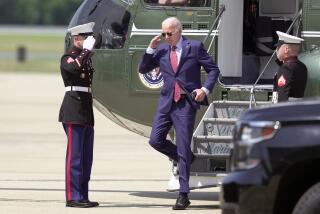Radar Choreographed the Allies’ Aerial Ballet : Tactics: An elaborate network coordinated 24 types of aircraft from five nations during Iraq raids.
WASHINGTON — The long-awaited air war that opened Operation Desert Storm had all the precision of an aerial ballet, choreographing the lethal work of 24 types of aircraft from four fiercely independent U.S. military services and four allies’ air forces.
And the Pentagon’s ability to carry it off rested on a complex system of air-traffic control and combat management every bit as sophisticated as the “smart” bombs and other space-age armaments used in the raids.
Elaborate radar networks integrated and presided over by computer systems, some of them carried aloft on AWACS planes, were indispensable in enabling American commanders to mount attacks considerably more complicated than anything previously possible.
“It’s a crowded airspace up there,” said Rep. Dave McCurdy (D-Okla.), a leading member of the House Armed Services Committee and an Air Force reservist. “This makes O’Hare (International Airport in Chicago) look like nothing. What is amazing to me is that there were not more mishaps. I would have expected more casualties just because of the crowded sky.”
The U.S.-led coalition’s losses--one American aviator killed, three warplanes lost and four more damaged--were hardly higher than those the Pentagon would expect from an intensive air exercise in peacetime, said several military officials.
In the 14 hours after “H-hour,” hundreds of fighter-bombers lifted off from airfields and carrier decks hundreds of miles apart and converged on targets across Iraq and Kuwait at different speeds and from different directions and altitudes, achieving near-total surprise.
To add to the challenge, the air armada operated under some of the most stringent guidelines ever imposed to minimize harm to civilians and cultural sites. One in five of the aircraft sent forward to bomb Iraqi targets turned back because mechanical failures, weather or other unforeseen problems prevented pilots from “eyeballing” targets.
Given the strict conditions, Pentagon officials said the resulting 80% effectiveness rate would make the crustiest wing commander proud.
But while Pentagon officials savored initial successes, they warned that dangers lie ahead. The initial wave of aircraft has taken out many of the surface-to-air missiles that are a pilot’s most deadly enemies.
But as the air war continues for what is expected to be a week to 10 days, the elusiveness of the warplanes’ targets--such as the Iraqis’ mobile missile launchers that may have been involved in the attack on Israel--will increase.
That development, in turn, will demand more improvisation--and more time spent lingering over hostile airspace--from pilots.
The rising confusion and the heavier gunfire could mean more losses ahead. And Iraq’s attack on Israel added a potentially deadly wild card.
Even before that attack, Defense Secretary Dick Cheney warned that “it is important . . . to be careful about claiming victory or making assumptions about the ultimate cost of this operation in terms of casualties.”
Early Thursday, however, Pentagon officials had to struggle to temper their euphoria over an opening gambit that appeared to have claimed few civilian casualties and even fewer losses to the anti-Iraq coalition.
“This is a vindication of what we’ve been saying air power is supposed be--speed, range and lethality,” one Air Force officer said. “Sometimes you look back and say, my gosh, your training, intelligence systems, communications and target selection really paid off.”
It was also, said another senior Air Force officer, a battle plan that in its scale and complexity could not have been possible without the airborne command-and-control post called AWACS. In the skies over Saudi Arabia, five AWACS planes were aloft throughout the massive air assault to warn aircraft of air threats and to impose order on the swarm of dissimilar aircraft.
Cheney and Gen. Colin L. Powell, chairman of the Joint Chiefs of Staff, said fighter and bomber aircraft from all three military services and the Marines--including Apache helicopters, which targeted ground units and artillery along the Saudi-Kuwait border--took part in the opening air war. Attacking the targets that required greatest accuracy were F-117 Stealth fighters, F-15E Eagles equipped with night-attack pods and F/A-18 fighter-bombers.
At the tip of the orchestrated air attack, the U.S. battleships Wisconsin and Missouri launched more than 100 Tomahawk cruise missiles, which arrived on target at precisely 3:01 a.m. Thursday. Officials said the weapons were chosen to target fixed sites close to densely populated areas.
Britain, Saudi Arabia, Kuwait and France also dispatched attack planes.
As nighttime air raids gave way to daylight, the Navy and Air Force also used older planes armed with “precision-guided munitions” that use sensors to help find their own way into targets.
Throughout the day Thursday, B-52 bombers newly arrived in the Middle East also bombarded targets in Iraq and Kuwait, including presidential guard units.
“Night is the world of magic aircraft and dumb bombs,” said a top Air Force analyst. “Daytime is a world of smart weapons and dumb aircraft.”
DESERT STORM LOSSES:
United States: Navy F/A-18 Hornet fighter attack jet shot down. It was based on the carrier Saratoga. Pilot is still missing.
Britain: One Tornado GR1 fighter-bomber suffered an engine fire; its tow-man crew is missing in desert. A second Tornado was later reported lost.
Kuwait: A Kuwaiti Warplane of the exiled government was also lost and its pilot is missing.
More to Read
Sign up for Essential California
The most important California stories and recommendations in your inbox every morning.
You may occasionally receive promotional content from the Los Angeles Times.










